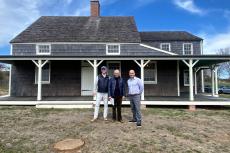In a virtual meeting of the Rhode Island Coastal Resources Management Council on Tuesday night, members of its fisheries advisory board strongly objected to the council's conclusion that the South Fork Wind Farm's new "minimization alternative" -- 12 wind turbine generators instead of 15, reducing its footprint -- and a $12 million fisheries compensation package, are consistent with the state's Ocean Special Area Management Plan.
The advisory board also took exception to the state council's inclination to issue "conditional concurrence" pursuant to federal regulations. The project needs the council's approval, along with that of a host of other state, federal, and local authorities.
The wind farm as first proposed called for a 15-turbine, 90-megawatt setup. Advances in technology have allowed instead for a 130-megawatt installation, using no more than 15 turbines. The South Fork Wind Farm will now have 12 wind turbine generators, its developers having entered into a contractual obligation with Siemens Gamesa Renewable Energy for 11-megawatt turbines.
The developers, Orsted U.S. Offshore Wind and Eversource Energy, have also modified the layout, to a one-by-one nautical-mile grid.
"We're pleased that the Rhode Island Coastal Resources Management Council is recommending a consistency certificate for South Fork Wind, advancing this first New York offshore wind farm and bringing much needed jobs and clean energy to the region," said Meaghan Wims, a spokeswoman for the developers. The $12 million compensation agreement, to be distributed over the life of the project, "is grounded in world-class fisheries analysis from Woods Hole Oceanographic Institution," Ms. Wims said, "and it's one we make in the spirit of negotiations to move this first Orsted-Eversource project forward."Ê
More details were revealed during the council's meeting, which continued for over five hours, including noise-attenuation when the turbine foundations are driven into the seabed. James Boyd, a member of the council who prepared the staff summary report, said the effort is expected to achieve 10 decibels of noise reduction, though "there will still be significant noise impacts to marine life."
Turbine installation is expected to happen over four months, Mr. Boyd said, each installed over two to four days with pile-driving occurring for two hours at a time. Noise generated by pile-driving has the potential to affect fish for a distance of eight miles, he said. A consultant to the developers has estimated that fish may not return to the affected area for up to two months following construction.
The fisheries advisory board balked at the plans as presented. "My clients were this close to boycotting this meeting," Marisa Desautel, an attorney for the board, told the council, holding her thumb and index finger close together. Seven members of the board and an economist speaking on their behalf told the council that the compensation package, $12 million over 30 years, or $5.2 million if paid up front, is inadequate for what they believe will be long-lasting or even permanent disruption to fertile fishing grounds.
Ms. Desautel referred to East Hampton Town and the town trustees' host-community agreement with the developers of almost $29 million over 25 years. Under that agreement, the developers will land the wind farm's export cable at the ocean beach at the end of Beach Lane in Wainscott and bury it on a path to a Long Island Power Authority substation in East Hampton. That agreement is "for an easement, a right of way," Ms. Desautel said. The advisory board, she said, "is being offered $5.2 million where there's far more at stake than an easement." She asked that the council vote to object to the project, rather than issue conditional concurrence.
At 11 p.m. on Tuesday, the council had yet to open the meeting to public comment, and resolved to continue its deliberations on Wednesday at 5 p.m.
In addition to East Hampton and the town trustees' approval of the wind farm, the New York State Public Service Commission has issued the developers a Certificate of Environmental Compatibility and Public Need, under its review process known as Article VII. The wind farm, one of many planned off the mid-Atlantic coast, remains under review by the federal Bureau of Ocean Energy Management.



